Table of Contents
Cows are more than just an iconic symbol of rural life—they are the backbone of American agriculture. With a wide variety of cow breeds thriving across the country, each one contributes uniquely to the farming and food production landscape. From the dairy-rich Holstein to the beefy Angus, the versatility of these animals is remarkable.
Understanding cow breeds is essential for anyone looking to dive into cattle farming or simply appreciate the role these animals play in our lives. Whether you’re a seasoned rancher, a small-scale farmer, or just a curious enthusiast, this guide offers a detailed look at 18 common cow breeds in the U.S. Discover their origins, traits, and what makes each one special.
The Role of Cattle in American Agriculture
Cattle were first introduced to the Americas by Spanish explorers in the 16th century. Over time, they became a cornerstone of agricultural development, with settlers bringing diverse breeds suited to specific climates and farming needs.
Today, the U.S. cattle industry is divided primarily into two sectors: dairy and beef production. According to USDA data, there are over 90 million cattle in the country, contributing significantly to the economy and food supply chain.
Choosing the right cow breed impacts productivity, cost efficiency, and sustainability. Breeds differ in adaptability, temperament, and output, making it essential to align your choice with your goals—whether for dairy, beef, or dual-purpose farming.
What Makes a Cow Breed Unique?
The term cow breeds refers to distinct groups of cattle with shared genetic traits, bred over time for specific qualities. These traits can include adaptability to certain climates, milk or meat production capabilities, size, and temperament.
Selecting the right breed is crucial for any farmer, whether you’re running a large-scale operation or managing a small family farm. A dairy farmer might prioritize breeds with high milk yields, while a rancher might prefer breeds known for premium beef quality.
18 Common Cow Breeds in the U.S.
The United States is home to a diverse range of cow breeds, each with unique traits that make them well-suited for specific purposes, environments, and farming operations. Below is a detailed look at 18 common cow breeds, highlighting their origins, characteristics, uses, and contributions to American agriculture.
1. Angus
- Origin and History: Angus cattle originated in Scotland’s Aberdeen and Angus counties. First imported to the U.S. in 1873, they quickly gained popularity due to their hardiness and exceptional meat quality.
- Physical Characteristics: Known for their black or red coats and polled nature (absence of horns). They are medium to large in size with a muscular build.
- Primary Use: Predominantly beef production.
- Notable Features: Angus beef is highly prized for its marbling, which enhances flavor, tenderness, and juiciness. They are also adaptable to various climates and efficient converters of feed to muscle.

2. Hereford
- Origin and History: Bred in Herefordshire, England, for their ability to thrive on low-quality pastures. Imported to the U.S. in the early 19th century.
- Physical Characteristics: Herefords are easily recognized by their reddish-brown bodies and white faces, legs, and underbellies.
- Primary Use: Beef production.
- Notable Features: Hardy, docile, and able to adapt to extreme weather conditions. They are a favorite among ranchers for their efficient grazing habits and ease of handling.
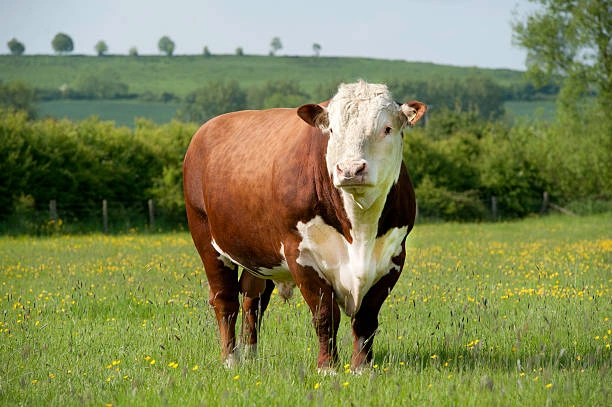
3. Holstein
- Origin and History: Holsteins originated in the Netherlands and were introduced to America in the 1850s.
- Physical Characteristics: Their striking black-and-white spotted coat is iconic, though some Holsteins have a red-and-white pattern.
- Primary Use: Dairy production.
- Notable Features: They are the highest milk producers among dairy breeds, with an average of over 25,000 pounds of milk per cow annually. This efficiency has cemented their status as the backbone of the U.S. dairy industry.
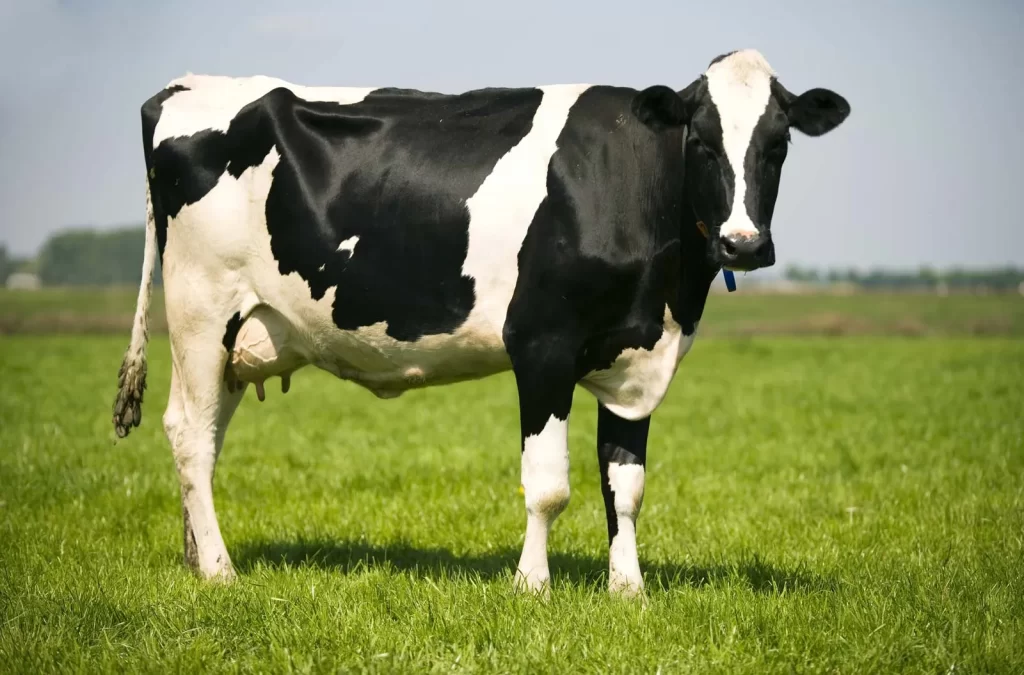
4. Jersey
- Origin and History: Jersey cattle hail from the Channel Island of Jersey and were introduced to the U.S. in the 19th century.
- Physical Characteristics: Smaller in stature than other dairy breeds, with a light brown coat and darker points on the muzzle, hooves, and tail.
- Primary Use: Dairy production.
- Notable Features: Jerseys produce milk with the highest butterfat content, making it ideal for premium dairy products like cheese and butter. They are also known for their gentle disposition and efficient feed conversion.

5. Charolais
- Origin and History: Charolais cattle trace back to the Charolles region of France, with imports to the U.S. beginning in the 1930s.
- Physical Characteristics: These large, muscular cattle are typically white or cream-colored with a short coat.
- Primary Use: Beef production.
- Notable Features: Known for their rapid growth, high yield of lean meat, and versatility in crossbreeding programs to improve the quality of other herds.

6. Simmental
- Origin and History: Developed in Switzerland over 1,000 years ago, Simmental cattle are one of the oldest and most widely distributed breeds worldwide.
- Physical Characteristics: Red-and-white or gold-and-white coats, often with white patches on the face.
- Primary Use: Dual-purpose, historically used for both dairy and beef production.
- Notable Features: They combine high milk production with excellent beef yield, making them a popular choice for diverse operations.

7. Limousin
- Origin and History: Native to France’s Limousin region, these cattle were introduced to the U.S. in the 1960s.
- Physical Characteristics: Golden-red or black coat with a lean, muscular frame.
- Primary Use: Beef production.
- Notable Features: Limousins are highly valued for their feed efficiency and lean, high-quality meat with minimal fat. They are also known for their ease of calving.

8. Brahman
- Origin and History: Descended from Bos indicus cattle in India, Brahmans were developed in the U.S. in the early 20th century.
- Physical Characteristics: Distinct features include a prominent hump over the shoulders, loose skin, and large, droopy ears.
- Primary Use: Beef production.
- Notable Features: Brahmans are highly resistant to heat, humidity, and pests, making them a staple in Southern states. Their adaptability to harsh climates is unmatched.

9. Red Angus
- Origin and History: A variation of the Angus breed, Red Angus cattle were developed in the U.S. by selecting naturally occurring red-coated animals from the black Angus population.
- Physical Characteristics: Similar to Angus but with a solid red coat.
- Primary Use: Beef production.
- Notable Features: The red coat offers improved heat tolerance, making them particularly suited for warmer climates.
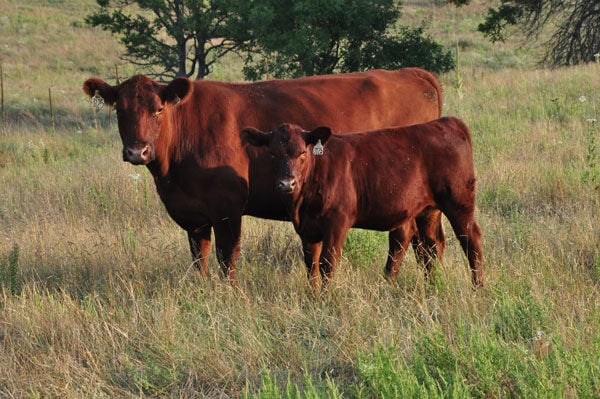
10. Guernsey
- Origin and History: From the Channel Island of Guernsey, this breed gained a foothold in the U.S. for its superior dairy qualities.
- Physical Characteristics: Fawn-and-white coat, medium size.
- Primary Use: Dairy production.
- Notable Features: Guernsey milk is rich in beta-carotene, giving it a distinctive golden hue and making it highly nutritious.
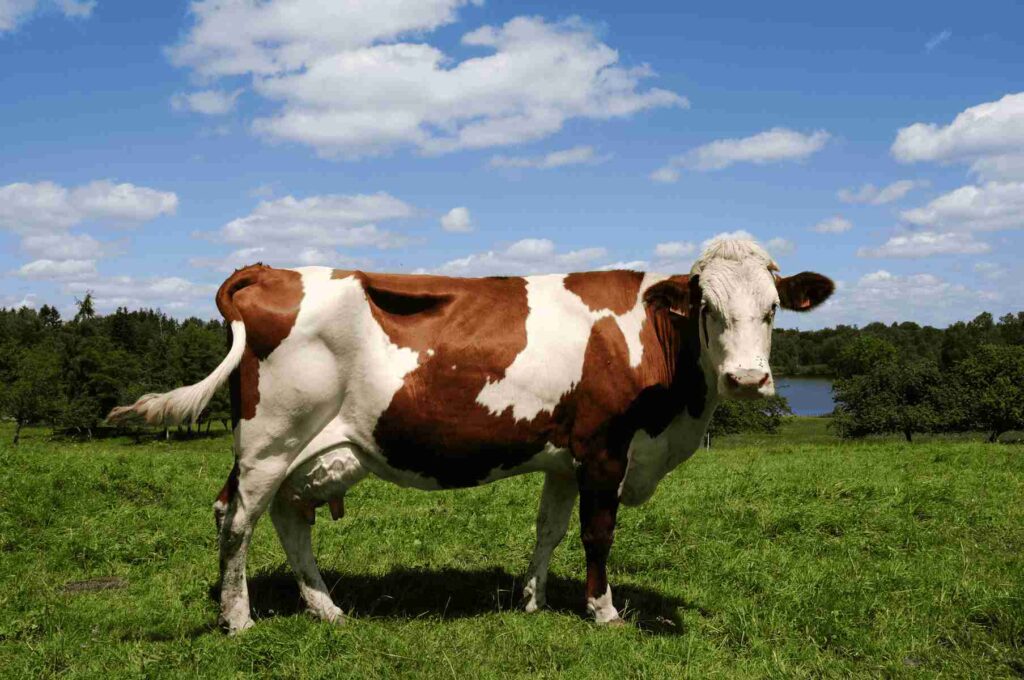
11. Shorthorn
- Origin and History: Developed in England and imported to America in the late 1700s.
- Physical Characteristics: Colors range from red and white to roan.
- Primary Use: Dual-purpose (dairy and beef).
- Notable Features: Shorthorns are renowned for their excellent maternal instincts and adaptability to various farming systems.

12. Brown Swiss
- Origin and History: One of the oldest dairy breeds, developed in Switzerland.
- Physical Characteristics: Light brown coat with a creamy muzzle and large, hardy frame.
- Primary Use: Dairy production.
- Notable Features: They produce milk with a high protein-to-fat ratio, ideal for cheese production.

13. Texas Longhorn
- Origin and History: A quintessential American breed, Texas Longhorns are descended from Spanish cattle brought to the Americas in the 1500s.
- Physical Characteristics: Long, curved horns; diverse coat colors and patterns.
- Primary Use: Beef production.
- Notable Features: Their ability to thrive on sparse pastures and resistance to disease make them an excellent choice for low-maintenance farming.

14. Gelbvieh
- Origin and History: Originated in Germany, bred for productivity and resilience.
- Physical Characteristics: Reddish-brown or black coat, medium to large size.
- Primary Use: Beef production.
- Notable Features: Gelbvieh cattle are prized for their excellent maternal traits and rapid growth rate.

15. Ayrshire
- Origin and History: Bred in Ayrshire, Scotland, and brought to the U.S. in the 19th century.
- Physical Characteristics: Red-and-white spotted coat.
- Primary Use: Dairy production.
- Notable Features: Ayrshires are efficient grazers and thrive in pasture-based dairy systems.

16. Brangus
- Origin and History: Developed in the U.S. by crossbreeding Brahman and Angus cattle.
- Physical Characteristics: Solid black or red coat, polled.
- Primary Use: Beef production.
- Notable Features: Combines the heat tolerance and resilience of Brahmans with the meat quality of Angus.

17. Belted Galloway
- Origin and History: Known as the “Oreo cow,” this breed was developed in Scotland.
- Physical Characteristics: Black body with a distinctive white band around the middle.
- Primary Use: Beef production.
- Notable Features: Belted Galloways are hardy and well-suited to colder climates.
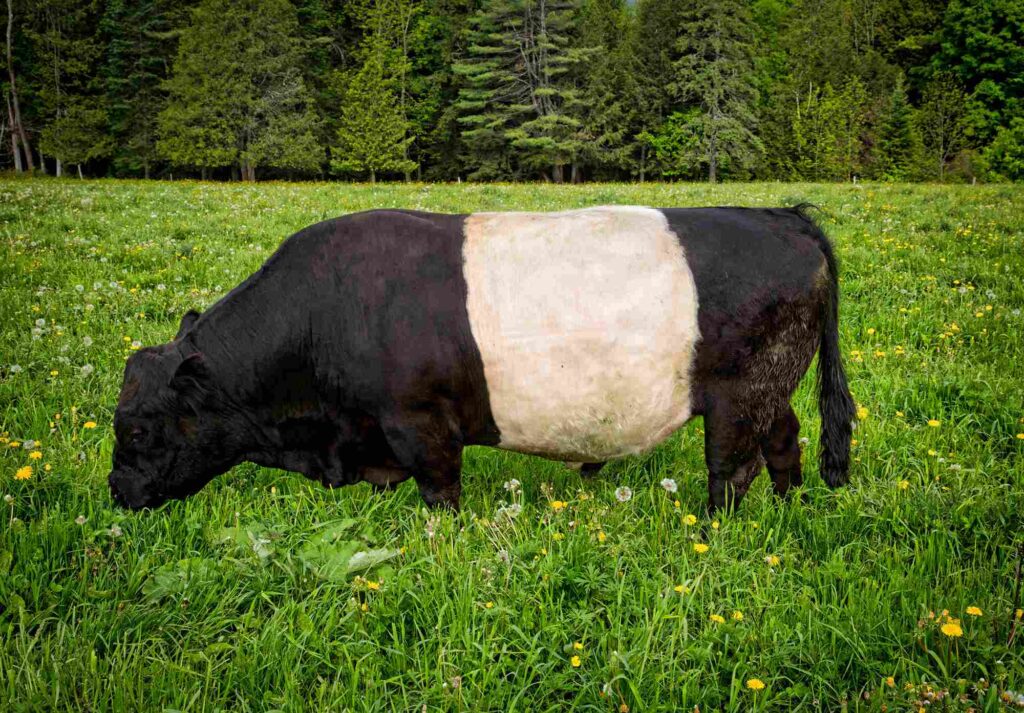
18. Dexter
- Origin and History: A small but mighty breed from Ireland, imported to the U.S. in the early 20th century.
- Physical Characteristics: Compact size, black or red coat.
- Primary Use: Dual-purpose.

Notable Features: Ideal for small-scale farming, offering both quality milk and tender beef.
This rich diversity of cow breeds showcases their immense value to American agriculture, making it easier to find a breed tailored to specific farming needs and environmental conditions.
How to Choose the Right Cow Breed for Your Needs
Selecting the right cow breed for your farm or operation is a critical decision that directly impacts productivity, profitability, and sustainability. The process involves understanding your goals, assessing your resources, and considering the breed’s unique characteristics. Here’s an in-depth guide to making an informed choice:
1. Identify Your Purpose
The first step in choosing the right breed is to define your primary objectives.
- Dairy Production: If your focus is on milk production, breeds like Holstein, Jersey, or Brown Swiss are ideal due to their high milk yields and rich butterfat content.
- Beef Production: For meat production, Angus, Hereford, and Charolais are preferred for their marbling, growth rate, and carcass quality.
- Dual-Purpose Breeds: Some breeds, like Shorthorn or Dexter, offer both milk and meat, making them versatile options for small-scale operations.
2. Consider Your Climate and Environment
Not all breeds adapt well to every region, so it’s essential to match the breed to your local climate.
- Hot and Humid Climates: Breeds like Brahman and Brangus excel in heat tolerance and pest resistance, making them suitable for Southern states.
- Cold Climates: Hardy breeds such as Hereford, Belted Galloway, and Scottish Highland are better equipped for colder environments.
3. Evaluate Available Resources
Your farm’s resources, including space, feed availability, and water supply, influence the choice of breed.
- Feed Efficiency: Breeds like Jersey and Limousin are known for their efficient feed-to-output ratio, reducing overall costs.
- Pasture Conditions: Grazing-oriented breeds, such as Texas Longhorns, can thrive on sparse pastures, while dairy breeds often require more nutrient-rich feed.
4. Analyze Breed Characteristics
Each breed has traits that may align better with your operational goals:
- Temperament: Calm breeds like Hereford or Shorthorn are easier to manage, especially for beginners.
- Growth and Maturity Rates: Fast-growing breeds like Charolais offer quicker returns, while slower-growing breeds may yield higher-quality beef or milk over time.
- Crossbreeding Potential: Some breeds, such as Angus, are ideal for crossbreeding to improve herd performance.
5. Long-Term Goals and Market Demand
Consider market trends and long-term plans when selecting a breed:
- Consumer Preferences: Angus beef is highly sought after, while Guernsey milk’s golden hue appeals to health-conscious buyers.
- Specialty Markets: Breeds like Belted Galloway, with their unique appearance, may serve niche markets looking for heritage or exotic breeds.
By carefully evaluating these factors, you can choose a cow breed that aligns with your needs, enhances your farm’s productivity, and ensures long-term success.
Conclusion
The diversity of cow breeds is a testament to their importance in American agriculture, offering solutions for every climate, farm size, and farming goal. From dairy cows producing rich milk to beef cattle prized for their marbling, each breed carries a legacy of resilience and productivity.
Selecting the right breed isn’t just about farming; it’s about aligning your values, resources, and goals with the unique traits of these animals. With this guide, you’re well on your way to understanding the distinct strengths of the most common cow breeds.
Now it’s your turn—what’s your favorite breed? Have you worked with any of these cows? Share your experiences and thoughts in the comments below!








